Top Rankings
Ross Valley Elementary School District ranks among the top 20% of public school district in California for:
Category
Attribute
Overall Rank
Highest overall rank (Top 5%)
Math Proficiency
Highest math proficiency (Top 5%)
Reading/Language Arts Proficiency
Highest reading/language arts proficiency (Top 5%)
Science Proficiency
Highest science proficiency (Top 5%)
For the 2025 school year, there is 1 public middle school serving 628 students in Ross Valley Elementary School District. This district's average middle testing ranking is 10/10, which is in the top 5% of public middle schools in California.
Public Middle School in Ross Valley Elementary School District have an average math proficiency score of 57% (versus the California public middle school average of 31%), and reading proficiency score of 75% (versus the 46% statewide average).
Minority enrollment is 27% of the student body (majority Hispanic), which is less than the California public middle school average of 78% (majority Hispanic).
Overview
This School District
This State (CA)
# Schools
5 Schools
3,501 Schools
# Students
1,727 Students
1,854,363 Students
# Teachers
84 Teachers
87,821 Teachers
Student : Teacher Ratio
21:1
21:1
District Rank
Ross Valley Elementary School District, which is ranked #88 of all 1,925 school districts in California (based off of combined math and reading proficiency testing data) for the 2021-2022 school year.
Overall District Rank
#75 out of 1941 school districts
(Top 5%)
(Top 5%)
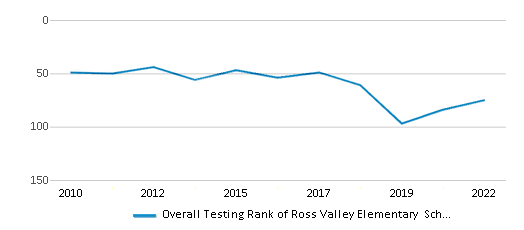
Math Test Scores (% Proficient)
65%
33%
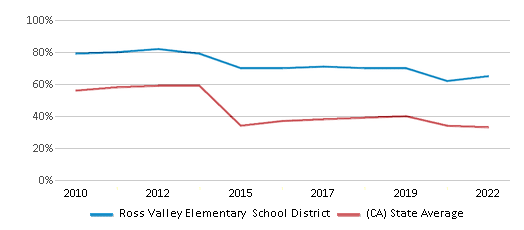
Reading/Language Arts Test Scores (% Proficient)
75%
47%
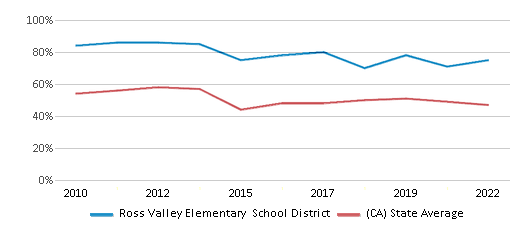
Science Test Scores (% Proficient)
59%
29%
Students by Ethnicity:
Diversity Score
0.46
0.64
# American Indian Students
5 Students
9,887 Students
% American Indian Students
n/a
1%
# Asian Students
49 Students
201,760 Students
% Asian Students
3%
11%
# Hispanic Students
228 Students
1,009,980 Students
% Hispanic Students
13%
55%
# Black Students
11 Students
97,908 Students
% Black Students
1%
5%
# White Students
1,243 Students
413,325 Students
% White Students
72%
22%
# Hawaiian Students
n/a
7,600 Students
% Hawaiian Students
n/a
n/a
# Two or more races Students
185 Students
109,003 Students
% of Two or more races Students
11%
6%
Students by Grade:
# Students in PK Grade:
-
83
# Students in K Grade:
247
90,358
# Students in 1st Grade:
155
70,728
# Students in 2nd Grade:
176
73,359
# Students in 3rd Grade:
150
73,090
# Students in 4th Grade:
183
76,068
# Students in 5th Grade:
188
82,191
# Students in 6th Grade:
217
289,122
# Students in 7th Grade:
198
439,549
# Students in 8th Grade:
213
441,705
# Students in 9th Grade:
-
59,696
# Students in 10th Grade:
-
51,846
# Students in 11th Grade:
-
51,149
# Students in 12th Grade:
-
55,419
# Ungraded Students:
-
-
District Revenue and Spending
The revenue/student of $17,685 in this school district is less than the state median of $19,974. The school district revenue/student has stayed relatively flat over four school years.
The school district's spending/student of $17,394 is less than the state median of $18,396. The school district spending/student has stayed relatively flat over four school years.
Total Revenue
$31 MM
$116,387 MM
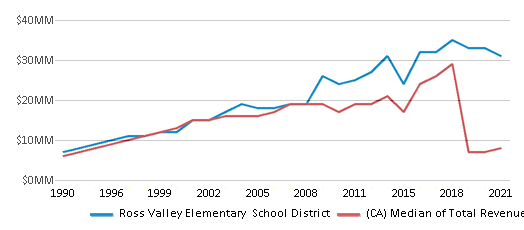
Spending
$30 MM
$107,188 MM
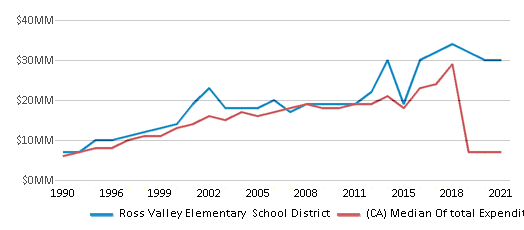
Revenue / Student
$17,685
$19,974
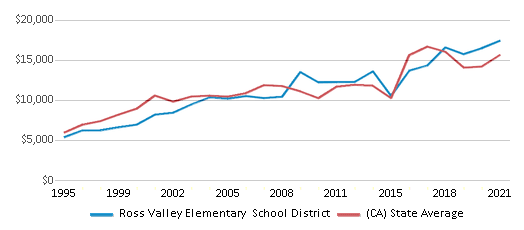
Spending / Student
$17,394
$18,396
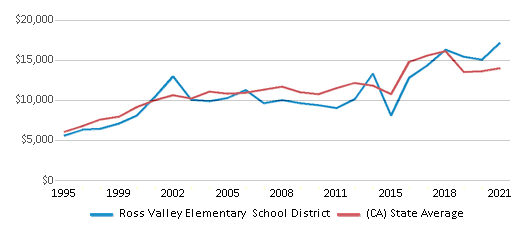
Best Ross Valley Elementary School District Public Middle Schools (2025)
School
(Math and Reading Proficiency)
(Math and Reading Proficiency)
Location
Grades
Students
Rank: #11.
White Hill Middle School
(Math: 57% | Reading: 75%)
Rank:
Rank:
9/
Top 20%10
101 Glen Dr.
Fairfax, CA 94930
(415) 454-8390
Fairfax, CA 94930
(415) 454-8390
Grades: 6-8
| 628 students
Recent Articles

Year-Round Or Traditional Schedule?
Which is more appropriate for your child? A year-round attendance schedule or traditional schedule? We look at the pros and cons.

Why You Should Encourage Your Child to Join a Sports Team
Participating in team sports has a great many benefits for children, there is no doubt. In this article you will learn what those benefits are.

White Students are Now the Minority in U.S. Public Schools
Increasing birth rates among immigrant families from Asia and Central and South America, combined with lower birth rates among white families, means that for the first time in history, public school students in the United States are majority-minority. This shift in demographics poses difficulties for schools as they work to accommodate children of varying language abilities and socio-economic backgrounds.





